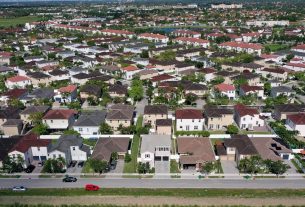Business is booming in Winnipeg’s industrial market, and it’s not expected to fizzle any time soon.
After adding more than 750,000 square feet of inventory in 2022, the Manitoba capital is forecasted for a strong 2023 that will bring on another million square feet in inventory while demand remains sky high, according to a recent national report from CBRE, a global real estate agency.
“Optimistic certainly,” said Paul Kornelsen, VP and managing director of CBRE Winnipeg.
MIKAELA MACKENZIE / WINNIPEG FREE PRESS
Possibly no project will contribute to the mass of acreage in the pipeline more than the CentrePort Canada Rail Park.
“The industrial market, I would say across the whole country — and similar to Winnipeg — is kind of the popular kid in school, the belle at the ball. It’s where a lot of the action is, it’s a good news story in terms of if you’re a developer or if you own industrial property. It’s in high demand everywhere.”
Indeed, the national vacancy rate average was under two per cent in Q4. Winnipeg’s meagre 1.9 per cent availability rate was among the highest in the country, according to the national report. Southwestern Ontario has the slimmest pickings, nursing a 0.9 per cent rate.
Kornelsen cautioned, however, that the amount of vacant space in Winnipeg is actually closer to 0.5 per cent (based on options with higher than 18-foot ceilings), as much of the excess supply in the city is deemed “functionally obsolete” and should be torn down or redeveloped.
“Winnipeg, for many years, has been a possible market for a lot of the national, international company, but when it comes to the inventory, it didn’t really match,” Kornelsen said. “What we’re finally starting to see is some momentum from developers that are building new product that is the Grade A stuff that we are seeing across the country.
“We’re starting to get that national interest inbound.”
Kornelson explained that Winnipeg has long lagged behind other markets in industrial space, but has caught up since 2021. Of the 13 markets examined for CBRE’s report, Winnipeg ranked sixth in inventory, boasting 85.89 million square feet of space.
“We’re in line. We’re getting there. But we’re running very fast to catch up,” he said.
“It is an advantage with what we have here. You look at what’s happening in mainland Vancouver, they have no land left to develop. Whereas, clearly we’re slated to bring on hundreds and hundreds of acres of development land in the coming years.”
Possibly no project will contribute to the mass of acreage in the pipeline more than the CentrePort Canada Rail Park, a 665-acre piece of land that finally put shovels in the ground in 2022 after more than a decade of contemplation.
The park is expected to connect rail-dependent heavy-industries needing 50-to-100 acres with Canadian Pacific’s main line in the northwest part of the city, with interconnections to CN and BNSF railways.
Potential tenants are already lining up to be part of the project that is expected to generate between $2 billion and $3 billion in development dollars alone and close to 5,000 new jobs for the province when the complex is built out over the next 10 to 20 years.
Developments in the NorthWest Business Park are also underway and expected to be ready at some point this year.
“There’s really an opportunity for Winnipeg to really be an economic hub for these users of industrial product,” Kornelsen said.

MIKAELA MACKENZIE / WINNIPEG FREE PRESS
CentrePort, where there is limited vacancy (like the rest of Winnipeg’s industrial sector), in Winnipeg on Friday, March 3, 2023.
The booming market hasn’t come without its challenges, however. As Kornelsen noted, “when demand is this high, everything is moving in that direction.”
Land prices are no exception. In 2021, it cost $333,000 per acre of industrial land in Winnipeg. That skyrocketed to $470,000 in 2022 and CBRE estimates it will reach $491,000 per acre this year.
Chris Macsymic has watched the booming market challenge his clients first-hand.
“There’s not a ton of shovel-ready land — we call it surface-zoned land. So if you’re looking to buy a site, there’s challenges there,” said Macsymic, principal and senior Vvice-president for Cushman & Wakefield Stevenson, which represents landlords and tenants in the industrial market.
“I think timelines are being pushed out on a lot of things,” he continued. “I think the cost of materials has largely stabilized, but the timing it takes to get materials, labour costs are more expensive and the whole supply chain is still an issue.”
Macsymic added it’s tough for landlords to find space if they need to grow or downsize. In saying that, there’s newer product that has come on in recent years, something that hasn’t always been prevalent. While hurdles are inevitable, the gross demand and healthy pipeline have Winnipeg buzzing in a thriving industry.
“I really can’t complain. Anybody who owns product here, as far as industrial, I think is doing well,” Macsymic said.
“It’s been a strong performing market for a number of years. This is just an even tighter market.”
Twitter: @jfreysam

Joshua Frey-Sam
Reporter
Joshua Frey-Sam happily welcomes a spirited sports debate any day of the week.



